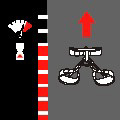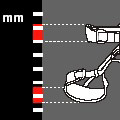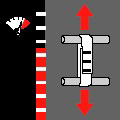Tests
| What is tested? | |
|---|---|
| Exactly what is tested, how are the tests conducted, and what do the results mean for the practical performance of harnesses? | |
| Pull from above | |

|
This test, in the standard loading situation, is the most important test of the standard. A dummy with the harness on is fixed in an upright «head up» position, the rope is tied according to standard, then the harness is statically loaded with a force of 15 kN (with children’s harnesses 10 kN). During this test, no force-carrying pieces are allowed to break, buckles are only allowed to slip a maximum of 20 mm (because of this slippage, a minimum remaining length of the harness webbing is necessary, see pg. 15). The test load of 15 kN contains a large safety reserve, because according to standard, the maximum impact force of a rope is not allowed to exceed 12 kN, and with falls that are braked dynamically, about 2.5 to 3.5 kN affects the body. That means: you would break your back long before the harness breaks. |
| Pull from below | |

|
For this test the dummy is put into a «head up» position and loaded with 10 kN from below (children’s harnesses 7 kN). All force-carrying pieces have to remain in tact, and the dummy is not allowed to slip out of the harness. That means: even jumping head first the harness holds without any problems. Of course head-first falls should be avoided if possible, but on ledgy rock faces, where the impact and twisting danger is especially high, put more protection in just in case! |
| Harness webbing width | |

|
All components in contact with the body have to, due to the sudden force transmission, have a minimum width. This varies for the waist and leg harnesses. The minimum widths are necessary so that, for example, the thighs are not injured by the leg loops during a fall. |
| Belay loop | |

|
The tear resistance of the belay loop is separately tested. The necessary values, to which the «pull from above» load corresponds (15 kN, children’s harnesses 10 kN), are more than sufficient. However we recommend not tying the rope on to the belay loop, but directly into the waist loop and leg loop base. This gives more safety when falling due to redundancy and avoids wear damage on the belay loop, which you need for clipping on rappel or belay devices. |






